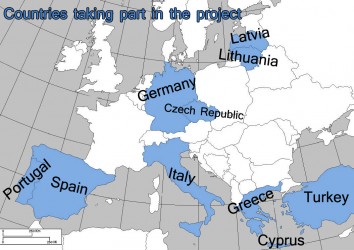On a very early Sunday morning a plane took off from Vilnius International airport and via Frankfurt headed to Porto. Ruta Turcinaviciute and Kristina Lavrukeviciute, students from the form 10a, and English teacher Jurgita Arbutaviciene started their journey to Portugal where they participated in the third meeting of the project.
When the plane landed, we were welcomed by modern Porto airport and pleasant warmth, we also had to turn our watches two hours back. We waited a little bit till Spanish Comenius team arrived to the Porto airport and then together we took a train to the centre of Porto where we had lunch and did some sightseeing. We walked along the Duero riverside admiring the bridge Ponte de D. Maria Pia designed by G. Eiffel and built in 1877. Then we took the Porto cable raiway and admired the wonderful views of the town.
Our final destination that day was Aveiro, it took us an hour to reach it by train from Porto. While sitting in the train and watching through the window, we enjoyed the breathtaking views of the Atlantic Ocean and the seaside with dark dunes, lots of lemon and orange – trees full of fruit on them growing near the houses in the seaside villages we were passing by… When we reached Aveiro, the host families were already waiting for us…















































